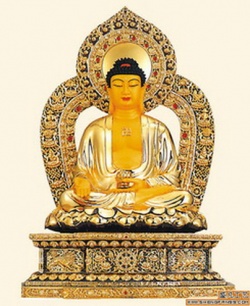The Treatise on the Sutra of Immeasurable Life
The Wang-sheng lun (T. 1524) is a commentary on the Sutra of Immeasurable Life which establishes the Indian master Vasubandhu as one of the two Indian patriatrchs of Pure Land Buddhism, along with Nagarjuna. As no extant copies of the Wang-sheng lun exist in Sanskrit or Tibetan, scholars have come to doubt whether the author is the same Vasubandhu who systematized the Yogacara school (Hirakawa, 101-11). The Wang-sheng lun, however, has been traditionally viewed by Chinese Pure land scholars as Vasubandhu's expression of his own desire to be born in the Pure land. The Wang-sheng lun is significant for the influence it had on the Chinese master T'an-luan (Jp. Donran). T'an-luan subsequently wrote a commentary on it called the Wang-sheng-lun chu, which taught that all beings can be born in the Pure land through the great Power of Amida's vow.
The Wang-sheng lun outlines five practices by which one can attain birth in Amida Buddha's Pure land:
1) Prostrating oneself before the Buddha.
2) Calling the Buddha's name and giving praise.
3) Single-mindedly desiring to enter the Pure land and concentrating on this goal.
4) Visualizing the Pure land, the Buddha and bodhisattvas through the eyes of Wisdom acquired by virtue of the above mentioned concentration.
5) Transferring to others the merit gained from the first four practices, so as to help them to enter the Pure land along with oneself.
As can easily be seen, these five practices center on intensely focusing the mind in order to visualize the Pure land and its magnificence. The Pure land is in fact the realm of Truth, but at the same time, it is a land where definite shapes and forms exist. According to the Wang-sheng lun, the Pure land possesses twenty-nine aspects (twenty-nine definite shapes) and came into being as a result of Amida Buddha's original vow. These five practices had a great influence on the development of Pure Land Buddhism in East Asia.
Of the treatises which Honen felt fully and properly explained birth in the Pure land, he listed only Vasubandhu's Wang-sheng lun. There are four other treatises which he regarded as incompletely expounding birth in the Pure land: the Ta-ch'eng chi-hsin lun attributed to Ashvaghosha, Saramati's Pao-hsing lun, the Shih-chu-p'i-p'o-sha lun attributed to Nagarjuna, and Asanga's She-ta-ch'eng lun. Eventually both the Wang-sheng lun and T'an-luan's commentary came to have a great influence on Honen who regarded it as the most important and fundamental of the treatises in establishing the Pure land school in Japan.
References:
Hirakawa Akira, Indo Bukkyoshi vol.2 (Tokyo: Shunjusha, 1979).
